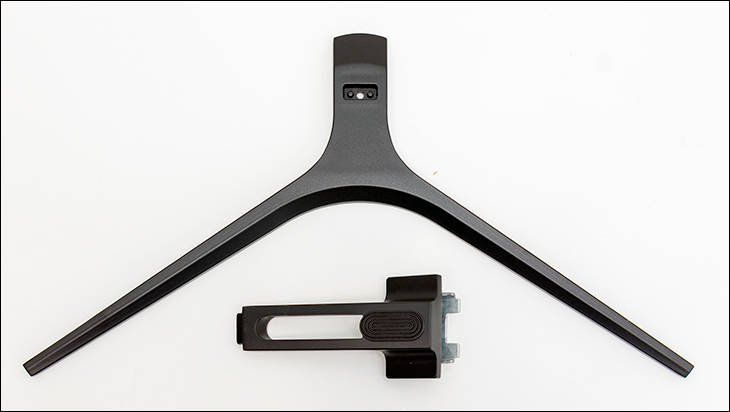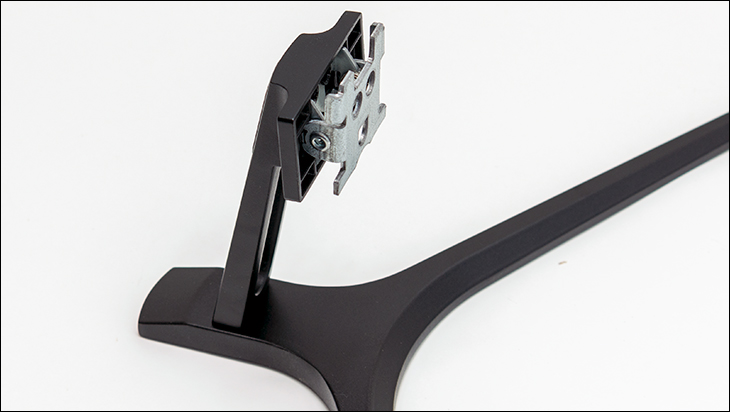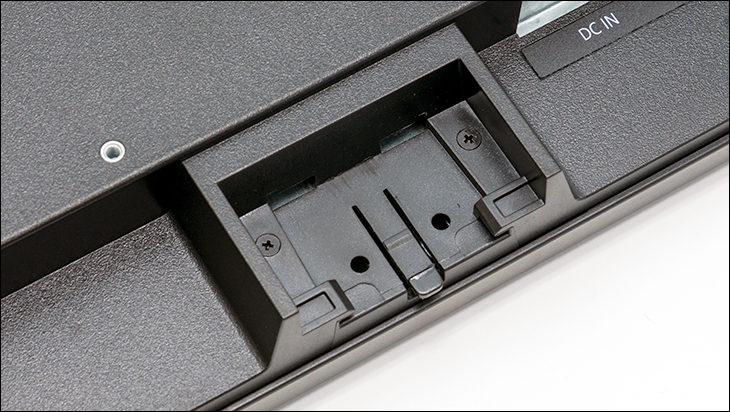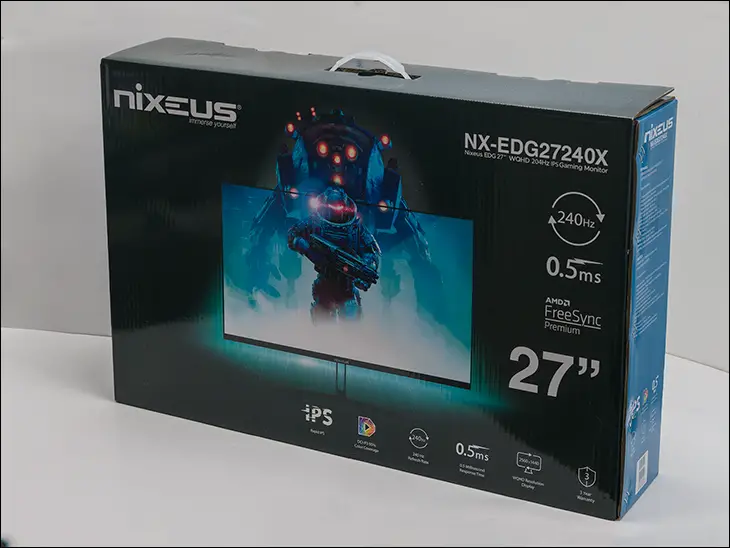
This brings us to the star of the show. As both the EDG27240X and EDG27X are “Designed For Gamers – Casual, Competitive, and eSports Professionals” both have their own strengths and weaknesses in the panel that Nixeus has paired to them. In the case of the EDG27X it is a 165Hz, LG (or ‘GoldStar’ as they used to be called before their rebranding) LM270WQA-SSA2 IPS “10 bit” panel with KSF coated (or ‘doped’) LEDs. This provided a 98% DCI-P3 color gamut with 400 (350 typical) lumens of backlighting goodness and comes with the standard LG anti-glare (25% Haze) 3H hard coating protection film covering said panel.
The new EDG27240X goes back to Nixeus roots and uses a AU Optronics AHVA M270DAN08.9 panel with White-LEDs. A panel that may ‘only’ come with 8bit RGB and 95% DCI-P3 coverage but in return for a slightly narrowing of the color range offers 240Hz abilities… with 400 (350 typical) lumens of backlighting goodness and standard anti-glare (25% Haze) 3H hard coating protection film covering said panel.
On paper the EDG27X is superior in color output abilities, and the EDG27240X is superior in frequency response rates. The reality is a bit more nuanced than the paper specifications would lead one to believe. Yes, the LG IPS panel is technically a 1.07B color capable panel with darn near full Adobe RGB coverage. In reality… it is using 2bit Frame rate control (FRC) to boost its 8bit panel ‘up to’ 10bit color depth. In other words, the panel will quickly switch between two different colors in a given pixel to ‘display’ a third color and give the illusion of 1.07billion color combinations. For most consumers faux 10bit is indistinguishable from ‘true’ 10bit. This is especially true when dealing with 165Hz refresh rate as even halving this frame rate still results in better than 60FPS which “10bit” media is (at best) recorded at. It however is a non-starter for professionals.
KSF backlighting technology is also still in its infancy and current gen KSF LEDs are garnering a bit of a negative reputation in certain circles. Namely Gaming Enthusiast circles… as the redshift that goes along with KSF is a real ‘thing’ and it takes a bit more effort to correct for it than with wLEDS.
Put simply, the wLED backlit AU Optronics panel that Nixeus is using is an excellent panel. It is extremely fast, it is extremely color accurate, and offers a fairly wide color gamut. One that is more than wide enough for home users and pro-sumers who do not want, need, or even desire full Adobe RGB color coverage. With that said, while it is an excellent panel Nixeus could have avoided a lot of confusion by opting for a different AUO model. Simply changing from the M270DAN08.9 to the M270DAN08.0 would have given the best of both worlds. QLED backlighting, full Adobe RGB color coverage via 8+2(FRC), 240Hz refresh rate and the same AHVA contrast and viewing angle goodness the EDG27240X offers. This however would have added (depending on order size) 100 to 200 dollars extra to the MSRP. We think it would have been worth it. With that change the main competition would not be $900 models but much pricier models like the Acer Nitro series. Hopefully, we will see a Nixeus “27240Xv2” with that panel and a better stand. In the meantime, this panel is excellent. It is rarely found in monitors in the sub $700 range and it is everything and a bag crisps that is sure to impress 99 percent of the buying public.

Now for the bad. Bad which we were not expecting, and it is the first premium line Nixeus monitor we have used that has been anything less than stellar in all key areas. Before we begin the vivisection of this ‘stand’ let’s back up for those who have not used a Nixeus EDG monitor in the past. Nixeus EDG monitors are known for their good stands. Stands that not only offer all the ‘premium’ features of more expensive manufacture’s options but also solid, confidence inspiring designs that Just Work™. Sure, sometimes the aesthetics or overall design was not perfect… but you could rely on it being a good, firm foundation for your new monitor.

The stand that comes with the EDG27240X offers none of that. Instead of continuing this tradition, this stand like substitute reminds us of early days Nixeus. Back when they did not know what their niche was and instead were just competing on price alone. Sometimes to beat other lesser-known manufacturers MSRP, sometimes just to beat the MSRP of Nixeus’ own ‘premium’ models. Typically models which did not round but out and out cut corners to keep the asking price down.

That is basically a great definition of what this stand is and why it has no place being on any $650 monitor… or any 27-inch monitor for that matter. Make no mistake, we fully understand that most people do not routinely use the advanced features of any monitor’s stand. Instead, they adjust it the way they want and then leave it alone. We appreciate the fact that this V-shaped stand is better than typical non-height adjustable stands in that it does offer tilt abilities. We even appreciate the fact that its height above your desk (about 9.5-inches inches from bottom of monitor) will be ‘good enough’ for most people’s desks. What we do not appreciate seeing on a $650 monitor is a stand that is flimsy, tippy, and oh so not confidence inspiring. Even small nudges to the monitor while using the included input buttons can (and do) make the entire EDG27240X rock back and forth like it was in the middle of a mini earthquake. As for gently bumps… they will cause the monitor to tip over. This is the definition of a NOT GOOD ENOUGH stand. This this is a stand meant to support a 24-inch monitor. Not a premium 27-inch monitor. This is a stand that dilutes the very ‘X’ branding Nixeus has been working so hard on making their flagship designation. Instead, this is a stand that belongs on a EDG240S model, not an ‘X’ branded model.

The reason for the sub-optimal abilities of this stand stems (mostly) from the connection hardware used to mount it in place. Instead of the typical Nixeus beefy metal hardware configuration the EDG240X relies mostly on plastic with small metal tab inserts. While there is nothing inherently wrong with using formed plastic and small locking tabs the margin of error is greatly reduced. The manufacturing process must have extremely precise tolerances so as to eliminate as much ‘wiggle’ or ‘slop’ as possible. Sadly, when ‘locked’ in place our sample easily moved side to side, front to back, and even diagonally – signifying less than perfect tolerances used. This is where the lack of stability stems from as monitor is only as secure as its weakest link. As such, in its current configuration, this stand cannot fully stabilize a 27-inch monitor.

Thankfully, the EDG27240X does come with an integrated 100×100 VESA mounting bracket, so it is not all that difficult to eliminate this issue. Furthermore, if you are planning a dual or tri-monitor setup you probably are investing in a good stand already. Thus, it too will be a non-issue for some. This however is not an assumption a monitor manufacture should ever make. Since they have taken a giant step backwards it does tarnish our overall opinion of the EDG2724X and turns a veritable no-brainer into excellent competition but one that needs a bit of TLC to be optimized for some-to-most gaming enthusiasts.









